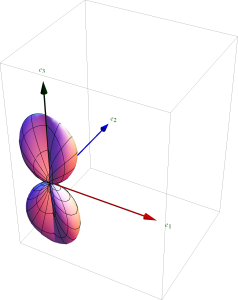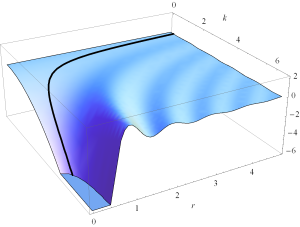[Click here for a PDF of this post with nicer formatting]
Separate examinations of the phasor form of Maxwell’s equation (with electric charges and current densities), and the Dual Maxwell’s equation (i.e. allowing magnetic charges and currents) were just performed. Here the structure of these equations with both electric and magnetic charges and currents will be examined.
The vector curl and divergence form of Maxwell’s equations are
\begin{equation}\label{eqn:phasorMaxwellsWithElectricAndMagneticCharges:20}
\spacegrad \cross \boldsymbol{\mathcal{E}} = -\PD{t}{\boldsymbol{\mathcal{B}}} -\BM
\end{equation}
\begin{equation}\label{eqn:phasorMaxwellsWithElectricAndMagneticCharges:40}
\spacegrad \cross \boldsymbol{\mathcal{H}} = \boldsymbol{\mathcal{J}} + \PD{t}{\boldsymbol{\mathcal{D}}}
\end{equation}
\begin{equation}\label{eqn:phasorMaxwellsWithElectricAndMagneticCharges:60}
\spacegrad \cdot \boldsymbol{\mathcal{D}} = \rho
\end{equation}
\begin{equation}\label{eqn:phasorMaxwellsWithElectricAndMagneticCharges:80}
\spacegrad \cdot \boldsymbol{\mathcal{B}} = \rho_m.
\end{equation}
In phasor form these are
\begin{equation}\label{eqn:phasorMaxwellsWithElectricAndMagneticCharges:100}
\spacegrad \cross \BE = – j k c \BB -\BM
\end{equation}
\begin{equation}\label{eqn:phasorMaxwellsWithElectricAndMagneticCharges:120}
\spacegrad \cross \BH = \BJ + j k c \BD
\end{equation}
\begin{equation}\label{eqn:phasorMaxwellsWithElectricAndMagneticCharges:140}
\spacegrad \cdot \BD = \rho
\end{equation}
\begin{equation}\label{eqn:phasorMaxwellsWithElectricAndMagneticCharges:160}
\spacegrad \cdot \BB = \rho_m.
\end{equation}
Switching to \( \BE = \BD/\epsilon_0, \BB = \mu_0 \BH\) fields (even though these aren’t the primary fields in engineering), gives
\begin{equation}\label{eqn:phasorMaxwellsWithElectricAndMagneticCharges:180}
\spacegrad \cross \BE = – j k (c \BB) -\BM
\end{equation}
\begin{equation}\label{eqn:phasorMaxwellsWithElectricAndMagneticCharges:200}
\spacegrad \cross (c \BB) = \frac{\BJ}{\epsilon_0 c} + j k \BE
\end{equation}
\begin{equation}\label{eqn:phasorMaxwellsWithElectricAndMagneticCharges:220}
\spacegrad \cdot \BE = \rho/\epsilon_0
\end{equation}
\begin{equation}\label{eqn:phasorMaxwellsWithElectricAndMagneticCharges:240}
\spacegrad \cdot (c \BB) = c \rho_m.
\end{equation}
Finally, using
\begin{equation}\label{eqn:phasorMaxwellsWithElectricAndMagneticCharges:260}
\Bf \Bg = \Bf \cdot \Bg + I \Bf \cross \Bg,
\end{equation}
the divergence and curl contributions of each of the fields can be grouped
\begin{equation}\label{eqn:phasorMaxwellsWithElectricAndMagneticCharges:300}
\spacegrad \BE = \rho/\epsilon_0 – \lr{ j k (c \BB) +\BM} I
\end{equation}
\begin{equation}\label{eqn:phasorMaxwellsWithElectricAndMagneticCharges:320}
\spacegrad (c \BB I) = c \rho_m I – \lr{ \frac{\BJ}{\epsilon_0 c} + j k \BE },
\end{equation}
or
\begin{equation}\label{eqn:phasorMaxwellsWithElectricAndMagneticCharges:340}
\spacegrad \lr{ \BE + c \BB I }
=
\rho/\epsilon_0 – \lr{ j k (c \BB) +\BM} I
+
c \rho_m I – \lr{ \frac{\BJ}{\epsilon_0 c} + j k \BE }.
\end{equation}
Regrouping gives Maxwell’s equations including both electric and magnetic sources
\begin{equation}\label{eqn:phasorMaxwellsWithElectricAndMagneticCharges:360}
\boxed{
\lr{ \spacegrad + j k } \lr{ \BE + c \BB I }
=
\inv{\epsilon_0 c} \lr{ c \rho – \BJ }
+ \lr{ c \rho_m – \BM } I.
}
\end{equation}
It was observed that these can be put into a tidy four vector form by premultiplying by \( \gamma_0 \), where
\begin{equation}\label{eqn:phasorMaxwellsWithElectricAndMagneticCharges:400}
J = \gamma_\mu J^\mu = \lr{ c \rho, \BJ }
\end{equation}
\begin{equation}\label{eqn:phasorMaxwellsWithElectricAndMagneticCharges:420}
M = \gamma_\mu M^\mu = \lr{ c \rho_m, \BM }
\end{equation}
\begin{equation}\label{eqn:phasorMaxwellsWithElectricAndMagneticCharges:440}
\grad = \gamma_0 \lr{ \spacegrad + j k } = \gamma^k \partial_k + j k \gamma_0,
\end{equation}
That gives
\begin{equation}\label{eqn:phasorMaxwellsWithElectricAndMagneticCharges:460}
\boxed{
\grad \lr{ \BE + c \BB I } = \frac{J}{\epsilon_0 c} + M I.
}
\end{equation}
When there were only electric sources, it was observed that potential solutions were of the form \( \BE + c \BB I \propto \grad \wedge A \), whereas when there was only magnetic sources it was observed that potential solutions were of the form \( \BE + c \BB I \propto (\grad \wedge F) I \). It seems reasonable to attempt a trial solution that contains both such contributions, say
\begin{equation}\label{eqn:phasorMaxwellsWithElectricAndMagneticCharges:480}
\BE + c \BB I = \grad \wedge A_{\textrm{e}} + \grad \wedge A_{\textrm{m}} I.
\end{equation}
Without any loss of generality Lorentz gauge conditions can be imposed on the four-vector fields \( A_{\textrm{e}}, A_{\textrm{m}} \). Those conditions are
\begin{equation}\label{eqn:phasorMaxwellsWithElectricAndMagneticCharges:500}
\grad \cdot A_{\textrm{e}} = \grad \cdot A_{\textrm{m}} = 0.
\end{equation}
Since \( \grad X = \grad \cdot X + \grad \wedge X \), for any four vector \( X \), the trial solution \ref{eqn:phasorMaxwellsWithElectricAndMagneticCharges:480} is reduced to
\begin{equation}\label{eqn:phasorMaxwellsWithElectricAndMagneticCharges:520}
\BE + c \BB I = \grad A_{\textrm{e}} + \grad A_{\textrm{m}} I.
\end{equation}
Maxwell’s equation is now
\begin{equation}\label{eqn:phasorMaxwellsWithElectricAndMagneticCharges:540}
\begin{aligned}
\frac{J}{\epsilon_0 c} + M I
&=
\grad^2 \lr{ A_{\textrm{e}} + A_{\textrm{m}} I } \\
&=
\gamma_0 \lr{ \spacegrad + j k }
\gamma_0 \lr{ \spacegrad + j k }
\lr{ A_{\textrm{e}} + A_{\textrm{m}} I } \\
&=
\lr{ -\spacegrad + j k }
\lr{ \spacegrad + j k }
\lr{ A_{\textrm{e}} + A_{\textrm{m}} I } \\
&=
-\lr{ \spacegrad^2 + k^2 }
\lr{ A_{\textrm{e}} + A_{\textrm{m}} I }.
\end{aligned}
\end{equation}
Notice how tidily this separates into vector and trivector components. Those are
\begin{equation}\label{eqn:phasorMaxwellsWithElectricAndMagneticCharges:580}
-\lr{ \spacegrad^2 + k^2 } A_{\textrm{e}} = \frac{J}{\epsilon_0 c}
\end{equation}
\begin{equation}\label{eqn:phasorMaxwellsWithElectricAndMagneticCharges:600}
-\lr{ \spacegrad^2 + k^2 } A_{\textrm{m}} = M.
\end{equation}
The result is a single Helmholtz equation for each of the electric and magnetic four-potentials, and both can be solved completely independently. This was claimed in class, but now the underlying reason is clear.
Because a single frequency phasor relationship was implied the scalar components of each of these four potentials is determined by the Lorentz gauge condition. For example
\begin{equation}\label{eqn:phasorMaxwellsWithElectricAndMagneticCharges:620}
\begin{aligned}
0
&=
\spacegrad \cdot \lr{ A_{\textrm{e}} e^{j k c t} } \\
&=
\lr{ \gamma^0 \inv{c} \PD{t}{} + \gamma^k \PD{x^k}{} } \cdot
\lr{
\gamma_0 A_{\textrm{e}}^0 e^{j k c t}
+ \gamma_m A_{\textrm{e}}^m e^{j k c t}
} \\
&=
\lr{ \gamma^0 j k + \gamma^r \PD{x^r}{} } \cdot
\lr{
\gamma_0 A_{\textrm{e}}^0
+ \gamma_s A_{\textrm{e}}^s
}
e^{j k c t} \\
&=
\lr{
j k
A_{\textrm{e}}^0
+
\spacegrad \cdot
\BA_{\textrm{e}}
}
e^{j k c t},
\end{aligned}
\end{equation}
so
\begin{equation}\label{eqn:phasorMaxwellsWithElectricAndMagneticCharges:640}
A_{\textrm{e}}^0
=\frac{ j} { k }
\spacegrad \cdot
\BA_{\textrm{e}}.
\end{equation}
The same sort of relationship will apply to the magnetic potential too. This means that the Helmholtz equations can be solved in the three vector space as
\begin{equation}\label{eqn:phasorMaxwellsWithElectricAndMagneticCharges:680}
\lr{ \spacegrad^2 + k^2 } \BA_{\textrm{e}} = -\frac{\BJ}{\epsilon_0 c}
\end{equation}
\begin{equation}\label{eqn:phasorMaxwellsWithElectricAndMagneticCharges:700}
\lr{ \spacegrad^2 + k^2 } \BA_{\textrm{m}} = -\BM.
\end{equation}
Like this:
Like Loading...



